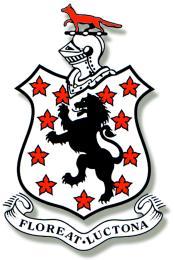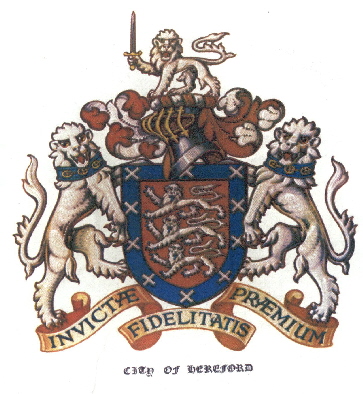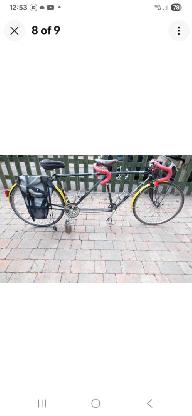 | UK National Tandem RallyAugust 20th. 2011- August 27th. 2011Lucton School |  |
|
|
|
|
|
|
|
|
|
|
This event was organised by Norman and Margaret Taylor.
The School, founded in 1708 by a London vintner, John Pierrepont, as a boy's school is now an independent mixed day and boarding school set in some of Herefordshire's most delightful countryside. The school is close to the tiny village which was incorporated into Yarpole parish many years ago. The original house, an attractive and symmetrical structure in red brick, has a contemporary clock in the pediment, a bell turret and a niche with a statue of the founder. The school, which suffered financial problems in recent years resulting in closure, was reopened as a result of the munificence of members of the Croft family and is now well re-established and thriving with well over 100 pupils. The Club had use of all the school's facilities for the week of the rally. A large level sports field for the campers, the boarding house, the school hall, dining room, covered and heated swimming pool and the tennis courts. The cricket pavilion was renamed 'The Tandem Inn' for the duration of the rally serving local ales and cider. The school provided a meal service for breakfasts, evening meals and lunch packs for those not wishing to do their own catering. Yarpole village shop and cafe proved a popular stop for supplies and morning coffee. North Herefordshire and its environs proved to be superb cycling country for young and old alike with a choice of three routes each day of different lengths.
Saturday started the rally with a half day ride of 20 miles to Leominster and back to get us warmed up in readiness for the week ahead and to do a bit of shopping.
During the day we were able to visit the following places:
KINGSLAND.An ancient village but still very active with school, garage, village stores and tea room and medical practice. There are two pubs and a cafe and all is ranged along the long main street with several fine properties. There is a 14th. Century church and a castle mound with moat reputedly built by King Merewald of Mercia.
EARDISLAND. One of the prettiest villages in Herefordshire set along the River Arrow. Children will enjoy feeding the ducks by the bridge. The 18th Century dovecote has been restored and nearby is the 14th Century yeoman's dwelling, the Staick House. There are two pubs and down the lane by the church there are tea rooms with craft shop.
BURTON COURT. 18th Century house, with a neo-Tudor front designed by Sir Clough Williams-Ellis of Portmeirion fame, built around a 14th Century Great Hall. The house contains exhibitions of costumes and toys.
DILWYN An attractive village with a green at its centre. There is a fine church, St. Mary's, which boasts the longest church key in the country at 17 inches (43cm).
LEOMINSTER. Pronounced Lemster! An ancient market town with a turbulent past which formerly prospered on the wool trade. Now it is the second largest town in the county - population 10,000 - with a growing antique trade. There are many fine streets and buildings including the impressive Priory Church with the famous ducking stool, magnificent Grange Court and the museum on Etnam Street.
YARPOLE The village, which is the centre of the parish in which Lucton is situated, was mentioned in Domesday. Until recent discreet development it was a farming village with a peaceful history disrupted only by the Battle of Mortimers Cross in 1461. Nearby is the Iron Age hillfort of Croft Ambrey, circa 400BC, and Croft Castle, occupied by the Croft family since Norman times and now administered by the National Trust. St Leonard's Church has a 13th. Century detached belfry. The day was rounded off with a 'Welcome Evening' and the rally was officially opened by local resident William Fotheringham, cycling correspondent for the Guardian. Musical entertainment was provided by members Tim and Paul Colling.
Sunday was devoted to the Club's annual Velocio competition. A test of navigation and map reading ability with a set of questions the answers to which could be found en route. In the evening members were able to take part in the swimming and running part of the fun triathlon.
Monday's rides were entitled 'Castles Galore' with all routes visiting Ludlow and its castle. The Market is still here and the bells of St Laurence's still ring out in this fine historic town with its 500 listed buildings and medieval street layout. The 900 year old castle, built to keep the Welsh at bay, became the headquarters of the Council of the Marches and was the last Royalist fortress to fall in the Civil War. The market and castle green was covered in tandems and tandemists taking a coffee or lunch break.
An early stop was at BERRINGTON HALL. A National Trust property built in 1783 by Henry Holland for Thomas Harley. The park was laid out by Capability Brown.
RICHARDS CASTLE is a beautiful 14th. Century church with a detached tower and close by the remains of a very early Norman castle founded by Richard FitzScrob, a Norman noble who actually lived in the castle before William the Conqueror landed.
WIGMORE CASTLE was built by the Mortimers who played a large part in our history and once one of the most powerful fortresses in the Marches.
STOKESAY CASTLE, One of the finest examples of a fortified manor house in England dating back to the 13th. Century.
BISHOPS CASTLE where the bishops of Hereford had a castle on land bequeathed by Egwin Shakehead who was cured of palsy at the Hereford shrine of St Ethelbert. Until 1965 it was the smallest borough in England. It is an utterly charming lazy unpretentious little market town well worth a potter round. The oldest inn, the Three Tuns, has its own Victorian tower brewery and the Six Bells by the church also brews.
HOPTON CASTLE was given by Henry II to one of his supporters in 1165 this Norman fortress suffered more at the hands of the English than of the Welsh. In 1644 it was held for the Parliamentarians by 33 men commanded by Samuel More against a Royalist force of 5000. After a month the Roundheads surrendered and the mound became slippery with their blood as they were massacred by the Royalists . The evening activities included a downhill freewheeling event, Rickard's Rockets (Water propelled lemonade bottles) and a video presentation.
Tuesday saw us visiting the Lugg, Teme and Clun Valleys with a superb coffee/lunch stop provided by volunteer ladies in Presteigne Memorial Hall.
Places visited included;
SHOBDON Church with a striking Georgian Gothic interior which we were unable to appreciate because of scaffolding erected to facilitate extensive work to prevent one of the walls collapsing. Shobdon Arches - resited remains of Norman church.
PRESTEIGNE and the award winning Judges Lodging and museum and St Andrew's Church. Radnorshire Arms in High St. is a fine timber framed building.
LINGEN.
PILLETH. The Battle of Pilleth was fought in 1402 when the army of Glyndwr with his Welsh archers led by Rhys Gethin inflicted terrible slaughter on the army of Edmund Mortimer. There were a thousand dead and the Welsh women inflicted shocking indignities on the corpses. (Cf. Shakespeare's Henry IV Part1 Act1 Scene1.) The Churchyard made an ideal picnic spot with splendid views down the Lugg Valley. MONAUGHTY. There once was a monastery here but nothing remains. Wonderful medieval house across the road once the home of the Sheriffs of Radnorshire but unfortunately not open to the public.
KNIGHTON or TREF-Y-CLAWDD. The town on the Dyke. A rural market town with a marked air of self sufficiency.
BRAMPTON BRYAN. Home of the Harleys (of Harley Street fame) since 1309. Lady Brilliana Harley in 1643 with a garrison of 100 defied the Royalists taking the entire village into the castle for protection.
LEINTWARDINE. Formerly the Roman town of Bravonium sited at the confluence of the Teme and the Clun. The church is built on a Saxon site on top of Roman remains. BURRINGTON. Cast iron grave 'stones' in the churchyard marking the graves of the ironfounders of Bringewood Chase where the essential charcoal was produced.
KNUCKLAS VIADUCT. Fine 19th.Century railway viaduct on the Central Wales Line.
CLUN noted for the toilets that played music while we......!
ASTON ON CLUN there are two circular stone houses and the new poplar called the Arbor Tree or Tree of All Nations in the village centre which is dressed with flags every Royal Oak day (29th. May). The previous tree was struck by lightning a few years ago.
The day finished with Magic in the Marquee and a barn dance.
Wednesday was a day free of organised routes with members able to follow their own ideas for the day. In the evening we had a picnic tea at Croft castle where we were able to hold the hill climb part of the triathlon. A Punch and Judy show entertained the children.
Thursday's ride was entitled 'Hop around Herefordshire'.
Places visited included;
HAMPTON COURT. This is the finest mansion in the county and was founded in 1430 from ransom money extracted from French nobles captured at Agincourt. It was extensively restored in the eighteenth century. The gardens, neglected for decades, have been restored and were well worth a visit.
BROADFIELD VINEYARD. A historic English house with a fine garden and a working vineyard which produces excellent wines which, of course, may be tasted.
HEREFORD. One of our smaller and more intimate cathedral cities standing at one of the major crossing points on the River Wye. The names of many famous people are associated with the town. Owen Tudor was executed in High Town after the battle of Mortimers Cross and the town is the birthplace of Nell Gwynne and also David Garrick. Have a look at the cathedral which was commenced in 1107. Adjacent is the exhibition building housing the Mappa Mundi and the Chained Library, both unique treasures. The top of Broad Street leads to the open centre known as High Town with the magnificent Old House, all that remains of 'Butchers Row' which stood here in 1612. Hereford is the home of Bulmers, the world famed cider producers founded here in the 19th Century.
KILPECK. Riders on the Long Route who had a spare moment were able to have a look at the splendid little Romanesque church of the 12th Century with its wonderful carvings.
The evening Saddlebag Sale was a popular event as it was held in the marquee which provided shelter from the rain. The Tandem Games had to be abandoned due to the wet conditions.
Friday dawned overcast and threatening rain. Those who got away early avoided the worst while the wise took shelter until later. The ride took us through some of Herefordshire's 'Black and White' Villages including;
WEOBLEY. Called 'The Jewel of Herefordshire' with its multitude of timbered houses and a fine church with a tall spire which dominates the landscape. A thriving village with two schools, several shops, three inns and two restaurants.
DUNKERTONS CIDER CO. One of the county's smaller cider makers. Some of us were able to call in and see how organic traditional Herefordshire cider is made and taste it - of course.
PEMBRIDGE. Another village stuffed with timber framed buildings. The New Inn was new in the 14th. Century and stands next to the Market Hall. Off the market square is the church of St Mary with its remarkable detached belfry.
SHOBDON AIRFIELD. This ex-WW2 airfield is now home to the Herefordshire Aero Club. Light aircraft, microlights, gliders and helicopters to be 'spotted' but little flying due to the adverse weather.
EARDISLEY. Picturesque ancient cottages flank the main Kington to Hereford road. The castle has long gone but the 12th. Century church with a fine Norman font was worth a visit. In 1974 a record breaking peal of 15,000 Doubles lasting 7 hours 22 minutes was rung on the church bells. The Tram Inn is named after the horse drawn Brecon to Kington tramway that ran until 1856.
KINGTON. One of the five market towns of Herefordshire, Kington is largely unspoiled by modern intrusions. The Lady Hawkins Grammar School was founded by the wife of John Hawkins, the Elizabethan sailor, in 1632. On nearby Bradnor Hill is the highest golf course in the country.
HAY ON WYE. Just over the Welsh border and sitting comfortably by the River Wye with the Black mountains as a backdrop Hay is an important market town. It is now best known as an international book centre attracting visitors from all over the world.
In the evening we ended the rally with the traditional BBQ followed by 'Song and Dance' with the 'Hillbillies'
Rally Pictures
Pictures from the rally can be viewed here.
Map showing location of Lucton School










